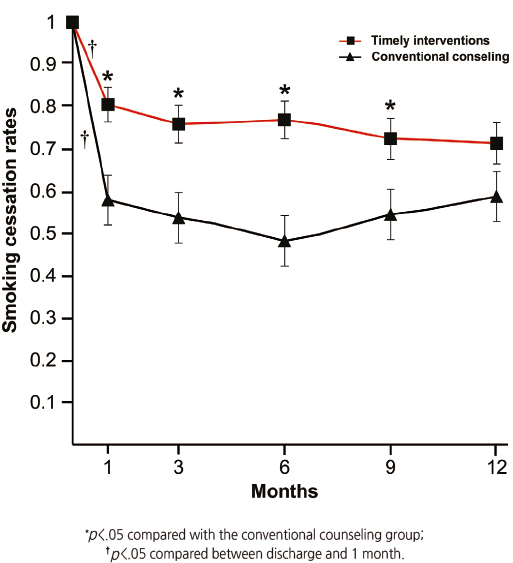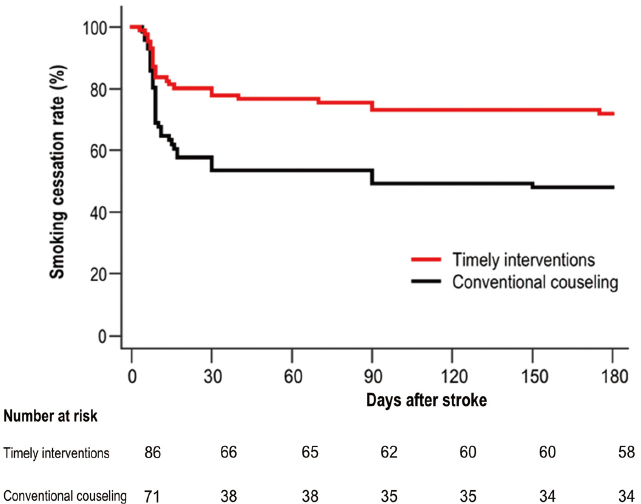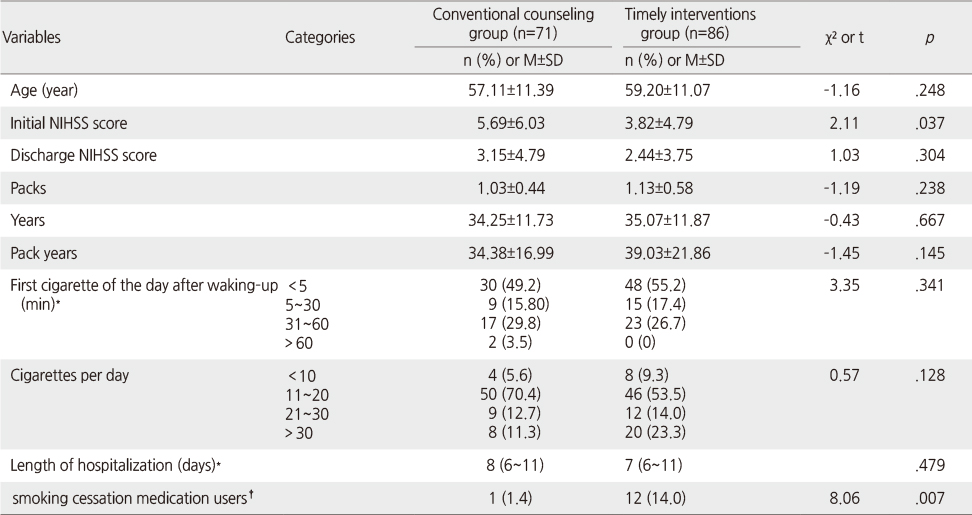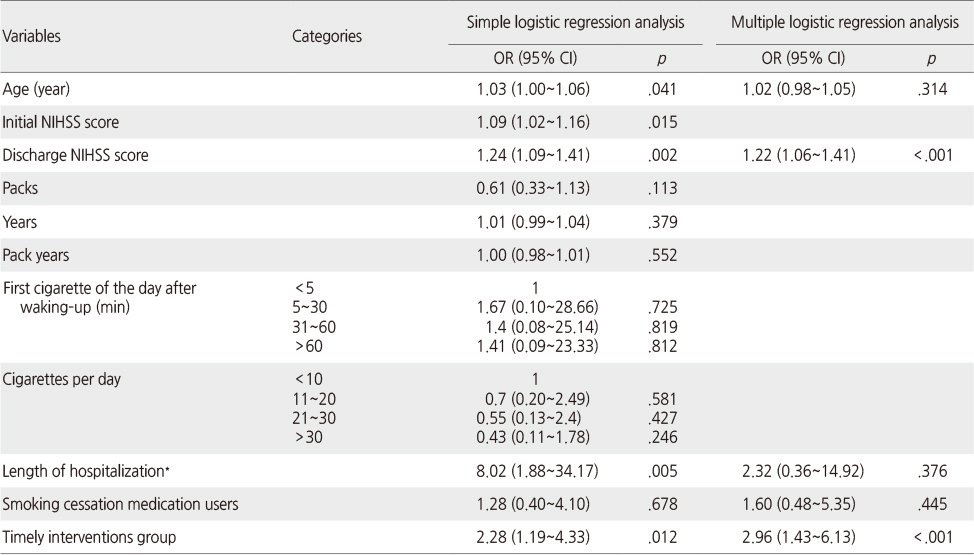Articles
- Page Path
- HOME > J Korean Acad Nurs > Volume 46(4); 2016 > Article
-
Original Article
- Timely Interventions can Increase Smoking Cessation Rate in Men with Ischemic Stroke
- Min Jeong Lee, Eunjeong Park, Hyeon Chang Kim, Hye Sun Lee, Myoung-Jin Cha, Young Dae Kim, Ji Hoe Heo, Hyo Suk Nam
-
Journal of Korean Academy of Nursing 2016;46(4):610-617.
DOI: https://doi.org/10.4040/jkan.2016.46.4.610
Published online: August 31, 2016
1Department of Neurology, Yonsei University College of Medicine, Seoul, Korea.
2Division of Nursing, Severance Hospital, Seoul, Korea.
3Department of Cardiovascular Research Institute, Yonsei University College of Medicine, Seoul, Korea.
4Department of Preventive Medicine, Yonsei University College of Medicine, Seoul, Korea.
5Biostatistics Collaboration Unit, (Department of Research Affairs) Yonsei University College of Medicine, Seoul, Korea.
- Address reprint requests to : Nam, Hyo Suk. Department of Neurology, Yonsei University College of Medicine, 50-1 Yonsei-ro, Seodaemun-gu, Seoul 03722, Korea. Tel: +82-2-2228-1617, Fax: +82-2-393-0705, hsnam@yuhs.ac
© 2016 Korean Society of Nursing Science
This is an Open Access article distributed under the terms of the Creative Commons Attribution NoDerivs License. (http://creativecommons.org/licenses/by-nd/4.0/) If the original work is properly cited and retained without any modification or reproduction, it can be used and re-distributed in any format and medium.
Abstract
-
Purpose
- Smoking cessation is strongly recommended for every smoker after ischemic stroke, but many patients fail to quit smoking. An improved smoking cessation rate has been reported with intensive behavioral therapy during hospitalization and supportive contact after discharge. The aim of this study was to demonstrate the usefulness of the timely interventions for smoking cessation in men with acute ischemic stroke.
-
Methods
- Patients who participated in the timely interventions strategy (TI group) were compared with those who received conventional counseling (CC group). In the TI group, a certified nurse provided comprehensive education during admission and additional counseling after discharge. Outcome was measured by point smoking success rate and sustained smoking cessation rate for 12 months.
-
Results
- Participants, 157 men (86 of the TI group and 71 of the CC group), were enrolled. Mean age was 58.25 ± 11.23 years and mean initial National Institutes of Health Stroke Scale score was 4.68 ± 5.46. The TI group showed a higher point smoking success rate compared with the CC group (p= .003). Multiple logistic regression analysis showed that the TI group was 2.96-fold (95% CI, 1.43~6.13) more likely to sustain smoking cessation for 12 months than the CC group.
-
Conclusion
- Findings indicate that multiple interventions initiated during hospital stay and regular follow-up after discharge are more effective than conventional smoking cessation counseling in men with acute ischemic stroke.
INTRODUCTION
METHODS
RESULTS
DISCUSSION
CONCLUSION
This research was supported by a grant of the Korea Health Technology R&D Project through the Korea Health Industry Development Institute (KHIDI), funded by the Ministry of Health & Welfare, Republic of Korea (HC15C1056).
The authors declared no conflict of interest.
- 1. Lee JH, Lee JY, Ahn SH, Jang MU, Oh MS, Kim CH, et al. Smoking is not a good prognostic factor following first-ever acute ischemic stroke. J Stroke. 2015;17(2):177–191. ArticlePubMedPMCPDF
- 2. Furie KL, Kasner SE, Adams RJ, Albers GW, Bush RL, Fagan SC, et al. Guidelines for the prevention of stroke in patients with stroke or transient ischemic attack: A guideline for healthcare professionals from the American Heart Association/American Stroke Association. Stroke. 2011;42(1):227–276. PubMed
- 3. Lancaster T, Stead LF. Individual behavioural counselling for smoking cessation. Cochrane Database Syst Rev. 2005;(2):CD001292ArticlePubMed
- 4. Stead LF, Lancaster T. Group behaviour therapy programmes for smoking cessation. Cochrane Database Syst Rev. 2005;(2):CD001007ArticlePubMed
- 5. Stead LF, Perera R, Lancaster T. Telephone counselling for smoking cessation. Cochrane Database Syst Rev. 2006;(3):CD002850. ArticlePubMed
- 6. Kim H, Kim O. The lifestyle modification coaching program for secondary stroke prevention. J Korean Acad Nurs. 2013;43(3):331–340. ArticlePubMed
- 7. Stead LF, Bergson G, Lancaster T. Physician advice for smoking cessation. Cochrane Database Syst Rev. 2008;(2):CD000165ArticlePubMed
- 8. Sauerbeck LR, Khoury JC, Woo D, Kissela BM, Moomaw CJ, Broderick JP. Smoking cessation after stroke: Education and its effect on behavior. J Neurosci Nurs. 2005;37(6):316–319. 325. ArticlePubMed
- 9. Sacco RL, Adams R, Albers G, Alberts MJ, Benavente O, Furie K, et al. Guidelines for prevention of stroke in patients with ischemic stroke or transient ischemic attack: A statement for healthcare professionals from the American Heart Association/American Stroke Association Council on Stroke: Co-sponsored by the Council on Cardiovascular Radiology and Intervention: The American Academy of Neurology affirms the value of this guideline. Stroke. 2006;37(2):577–617. ArticlePubMed
- 10. Oh SM, Stefani KM, Kim HC. Development and application of chronic disease risk prediction models. Yonsei Med J. 2014;55(4):853–860. ArticlePubMedPMC
- 11. Stringhini S, Spencer B, Marques-Vidal P, Waeber G, Vollenweider P, Paccaud F, et al. Age and gender differences in the social patterning of cardiovascular risk factors in Switzerland: The CoLaus study. PLoS One. 2012;7(11):e49443ArticlePubMedPMC
- 12. Lee BI, Nam HS, Heo JH, Kim DI. Yonsei stroke registry. Analysis of 1,000 patients with acute cerebral infarctions. Cerebrovasc Dis. 2001;12(3):145–151. ArticlePubMedPDF
- 13. Kernan WN, Ovbiagele B, Black HR, Bravata DM, Chimowitz MI, Ezekowitz MD, et al. Guidelines for the prevention of stroke in patients with stroke and transient ischemic attack: A guideline for healthcare professionals from the American Heart Association/American Stroke Association. Stroke. 2014;45(7):2160–2236. PubMed
- 14. Ives SP, Heuschmann PU, Wolfe CD, Redfern J. Patterns of smoking cessation in the first 3 years after stroke: The South London stroke register. Eur J Cardiovasc Prev Rehabil. 2008;15(3):329–335. ArticlePubMedPDF
- 15. Bruce N, Pope D, Stanistreet D. Quantitative methods for health research: a practical interactive guide to epidemiology and statistics. Wiley; 2013. p. 293.
- 16. Redfern J, McKevitt C, Dundas R, Rudd AG, Wolfe CD. Behavioral risk factor prevalence and lifestyle change after stroke: A prospective study. Stroke. 2000;31(8):1877–1881. ArticlePubMed
- 17. Bak S, Sindrup SH, Alslev T, Kristensen O, Christensen K, Gaist D. Cessation of smoking after first-ever stroke: A follow-up study. Stroke. 2002;33(9):2263–2269. ArticlePubMed
- 18. Sappok T, Faulstich A, Stuckert E, Kruck H, Marx P, Koennecke HC. Compliance with secondary prevention of ischemic stroke: A prospective evaluation. Stroke. 2001;32(8):1884–1889. ArticlePubMed
- 19. Rigotti NA, Munafo MR, Stead LF. Interventions for smoking cessation in hospitalised patients. Cochrane Database Syst Rev. 2007;(3):CD001837ArticlePubMed
- 20. Fiore MC, Jaén CR, Baker TB, Bailey WC, Benowitz N, Curry SJ, et al. Treating tobacco use and dependence: 2008 update. Quick reference guide for clinicians [Internet]. Rockville, MD, U.S. Department of Health & Human Services. 2008;cited 2016 January 1. Available from: http://www.ahrq.gov/professionals/clinicians-providers/guidelinesrecommendations/tobacco/clinicians/references/quickref/index.html
- 21. Ovbiagele B, Kidwell CS, Selco S, Razinia T, Saver JL. Treatment adherence rates one year after initiation of a systematic hospital-based stroke prevention program. Cerebrovasc Dis. 2005;20(4):280–282. ArticlePubMedPDF
- 22. McBride CM, Emmons KM, Lipkus IM. Understanding the potential of teachable moments: The case of smoking cessation. Health Educ Res. 2003;18(2):156–170.ArticlePubMed
- 23. France EK, Glasgow RE, Marcus AC. Smoking cessation interventions among hospitalized patients: What have we learned? Prev Med. 2001;32(4):376–388. ArticlePubMed
- 24. Rice VH, Stead LF. Nursing interventions for smoking cessation. Cochrane Database Syst Rev. 2008;(1):CD001188ArticlePubMed
- 25. Schuck K, Otten R, Kleinjan M, Bricker JB, Engels RC. Effectiveness of proactive telephone counselling for smoking cessation in parents: Study protocol of a randomized controlled trial. BMC Public Health. 2011;11:732ArticlePubMedPMCPDF
- 26. Zhou X, Nonnemaker J, Sherrill B, Gilsenan AW, Coste F, West R. Attempts to quit smoking and relapse: Factors associated with success or failure from the ATTEMPT cohort study. Addict Behav. 2009;34(4):365–373. ArticlePubMed
- 27. McRobbie H, Hajek P. Nicotine replacement therapy in patients with cardiovascular disease: Guidelines for health professionals. Addiction. 2001;96(11):1547–1551. ArticlePubMedPDF
REFERENCES
Estimated smoking cessation rates between the timely interventions and the conventional counseling groups.

Kaplan–Meier survival analysis between the timely interventions group and the conventional counseling group.

Figure & Data
REFERENCES
Citations

- Analysis of Factors Affecting the Intention to Quit Smoking in Stroke Patients
Junghee Youn, Mee Kyung Shin
The Korean Journal of Rehabilitation Nursing.2021; 24(1): 78. CrossRef - The experience of continued smoking after stroke in Korean males: A qualitative study
Jung Hee Youn, Sujin Shin
Nursing Open.2021; 8(5): 2750. CrossRef - Rates, Predictors, and Impact of Smoking Cessation after Stroke or Transient Ischemic Attack: A Systematic Review and Meta-Analysis
Jean Jacques Noubiap, John L. Fitzgerald, Celine Gallagher, Gijo Thomas, Melissa E. Middeldorp, Prashanthan Sanders
Journal of Stroke and Cerebrovascular Diseases.2021; 30(10): 106012. CrossRef - Smoking-cessation pharmacotherapy for patients with stroke and TIA: Systematic review
Neal S. Parikh, Setareh Salehi Omran, Hooman Kamel, Mitchell S.V. Elkind, Joshua Z. Willey
Journal of Clinical Neuroscience.2020; 78: 236. CrossRef - Guidelines for the Early Management of Patients With Acute Ischemic Stroke: 2019 Update to the 2018 Guidelines for the Early Management of Acute Ischemic Stroke: A Guideline for Healthcare Professionals From the American Heart Association/American Stroke
William J. Powers, Alejandro A. Rabinstein, Teri Ackerson, Opeolu M. Adeoye, Nicholas C. Bambakidis, Kyra Becker, José Biller, Michael Brown, Bart M. Demaerschalk, Brian Hoh, Edward C. Jauch, Chelsea S. Kidwell, Thabele M. Leslie-Mazwi, Bruce Ovbiagele, P
Stroke.2019;[Epub] CrossRef - Effects of a Nurse-Led, Stage-Matched, Tailored Program for Smoking Cessation in Health Education Centers: A Prospective, Randomized, Controlled Trial
Chia-Chen Lu, Yu-Chuan Hsiao, Hui-Wen Huang, Jhen-Yi Lin, Chih-Ling Huang
Clinical Nursing Research.2019; 28(7): 812. CrossRef - Assessment of factors associated with smoking cessation at diagnosis or during follow‐up of Crohn's disease
Eun Mi Song, Gwang‐Un Kim, Myeongsook Seo, Sung Wook Hwang, Sang Hyoung Park, Eunja Kwon, Ho‐Su Lee, Dong‐Hoon Yang, Kyung‐Jo Kim, Byong Duk Ye, Jeong‐Sik Byeon, Seung‐Jae Myung, Suk‐Kyun Yang
Journal of Gastroenterology and Hepatology.2018; 33(1): 180. CrossRef


Figure 1
Figure 2
Patient Characteristics in the Conventional Counseling Group and the Timely Intervention Group
NIHSS: National Institutes of Health Stroke Scale; * Data of 41 patients of the conventional counselling group are missing, values are median (25 percentile~75 percentile); †Smoking cessation medication includes bupropion, varenicline tartrate, and nicotine patch.
Generalized Estimating Equation Models for Smoking Cessation Rates
Simple and Multiple Logistic Regression Analyses of Sustained Smoking Cessation for 12 Months
OR=Odds ratio; CI=Confidence interval; NIHSS=National Institutes of Health Stroke Scale; *log-Transformation Data
NIHSS: National Institutes of Health Stroke Scale; * Data of 41 patients of the conventional counselling group are missing, values are median (25 percentile~75 percentile); †Smoking cessation medication includes bupropion, varenicline tartrate, and nicotine patch.
OR=Odds ratio; CI=Confidence interval; NIHSS=National Institutes of Health Stroke Scale; *log-Transformation Data
 KSNS
KSNS
 E-SUBMISSION
E-SUBMISSION



 Cite
Cite

